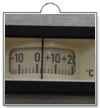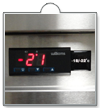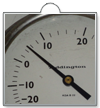- -Able to understand the 5 Food Safety Zones.
- -Able to read refrigeration thermometers and document temperatures.
- -Able to understand how to use, clean and calibrate a thermometer.
-
Food Safety Zones
To maintain a standard of food storage, being able to read and understand thermometers is important and a legal requirement under new food safety standards.
Click on the Play button to start the introduction video.
-
Show Me
Show Me
Food Safety Zones
Incorrect food storage is a major factor that could lead to food spoilage and food poisoning.
Incorrect storage can also contribute to cross contamination.
There are 5 very important temperature zones:
Danger Zone between 5oC and 60oC Safe Zone between 1oC and 4oC Frozen Zone between -18oC and -24oC Dry Storage Zone between 10oC and 15oC Reheating Food Zone 75oC and above Show Me
Reading Refrigeration ThermometersClick on the Play button to start the video.
Reading Refrigeration Thermometers and Recording Temperatures
Knowing how to read temperature gauges on fridges and freezers is important in the management of the kitchen.
Being able to read thermometers and document temperatures in food preparation and storage are part of the Food Safety laws.
Documentation of temperature readings needs to be completed at least three times a day.
Refrigeration and Freezer Temperatures
- Fridges need to run between 1oC and 4oC
- Freezers need to run below -18oC
These temperatures are important to maintain food safety.
Show Me
HACCP & Calibration of ThermometersClick on the Play button to start the video.
Hazard Analysis and Critical Control Points (HACCP) is a food safety program that tracks food from the farmers to the kitchen, through to the preparation and serving of food. If there is a case of food poisoning, through the HACCP program, the source of contamination can be tracked.
Thermometers are used to measure food temperatures during:
- storage
- transportation
- preparation and cooking
- selling
Temperature readings will alert you if the foods are being stored at incorrect temperatures, for example, cold meats being stored at 6oC, or frozen prawns in a freezer with a temperature reading of -10oC.
Thermometers must be calibrated regularly. This can be done using one of two methods:
- Ice Point - unless the temperature reads 0oC the thermometer must be re-calibrated
- Boiling Point - unless the temperature reads 100oC the thermometer must be re-calibrated
REMEMBER - Thermometers should be re-calibrated:
- Before using for the first time
- If they have been dropped
- If the same thermometer is used to measure very cold and very hot temperatures
- REGULARLY
-
Say It
There are 2 parts in this section.
1. The GlossaryThe glossary lists the more difficult words related to the topic in alphabetical order. The glossary also gives the meaning for each word.
2. Look, Cover, Write, Check!This activity gives you practice at remembering and writing the words from the glossary.
The Glossary
-
Do It
 Jump to Activities
Jump to Activities
Do It: Food Safety Zones

Do It: Reading Refrigeration Thermometers and Recording Temperatures
In the hospitality industry it is crucial to understand how to read a thermometer accurately.
Refrigeration temperatures need to be closely monitored and recorded.
Refrigerators for food and the bar need to be operating between 1 degree Celsius (1oC) and 4 degrees Celsius (4oC). Freezers should operate between minus 18 degrees Celsius (-18oC) and minus 24 degrees Celsius (-24oC)
Do It: HACCP and Calibration of Thermometers

Check It
Check It QuizFood Safety ZonesClick on Food Safety Zones to begin.
- Introduction
- Show Me
- Say It
- Do It
- Check It



















